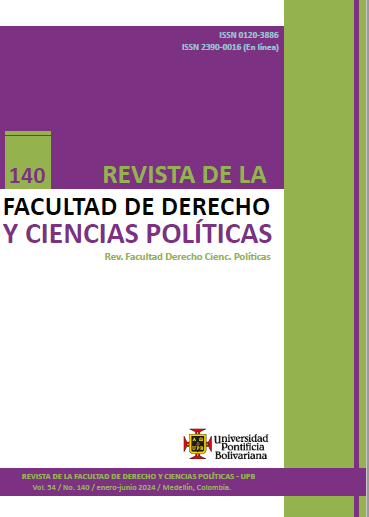Pena de muerte y cadena perpetua para menores infractores: la necesidad de combatir la crueldad con los estándares de decencia
Contenido principal del artículo
Resumen
La pena de muerte y la cadena perpetua son sanciones prohibidas por la Convención sobre los Derechos del Niño de 1989 para delitos cometidos por menores de 18 años, con base en la idea de que debe existir una respuesta penal diferenciada para los menores de edad y los adultos, lo que es especialmente importante cuando se trata de penas graves y crueles. Este artículo aborda la situación en los países que han suscrito dicha Convención; en especial Estados Unidos, el único país del mundo que no lo ha hecho, y cuya Constitución prohíbe las penas crueles e inusuales y cuya Corte Suprema ha declarado que el tratamiento penal diferenciado entre menores de edad y adultos es uno de los estándares de decencia que caracterizan a una sociedad civilizada.
Citas
ANDERSON, M., (2013), “The Eighth Amendment and Juvenile LWOP: Applying the Tison Standard
to Juvenile Peripheral Accomplices”, Mississippi Law Journal, 82, pp. 329 y ss.
BERRY, W.W. (2018), “Evolved Standards, Evolving Justices? The case for a broader Application of the Eighth Amendment”, Washington Law Review, vol. 96, pp. 150 y ss.
FRASE, R.S., («What´s “Different” (Enough) in Eight Anmendment Law?», Ohio State Journal of Criminal Law, (1-11), pp. 9 y ss.
KRAUSE, L.E., (2015) “One Size Does Not Fit All: The Need for a Complete Abolition of Mandatory Minimum Sentences for Juveniles in Response to Roper, Graham, and Miller”, Law and Inequality, 33, pp. 481 y ss.
MASSEY, H.J., (2006) “Disposing of Children: The Eight Amendment and Juvenile Life without Parole after Roper”, Boston College Law Review, (47), pp. 1083 y ss.
MARONEY, T.A. (2010), “The False Promise of Adolescent Brain Science in Juvenile Justice”, Notre Dame Law Review, (85), pp.119-122.
MCGREEVY, J., (2020), “Growing up in Prison: Rethinking Juvenile Offender Parole Hearings to Eliminate Essential Life Sentences”, Baltimore Law Review, pp. 221 y ss.
MÍNGUEZ ROSIQUE, M. (2021), “¿Cadena perpetua no revisable para menores de edad? Jones vs. Mississippi: crónica de un retroceso constitucional. Comentario a la Sentencia del Tribunal Supremo de los Estados Unidos de 22 de abril de 2021”, InDret, 3, pp. 323 y ss.
MURROCK, K.E., (2015), “A Coffin Was the Only Way out: Whether the Supreme Court's Explicit Ban on Juvenile Life without Parole for Non-Homicide Offenses in Graham v. Florida Implicitly Bans de Facto Life Sentences for Non-Homicide Juvenile Offenses” Civil Rights Law Journal, pp. 243 y ss.
POZUELO PÉREZ, L. (2015), “Sobre la responsabilidad penal de un cerebro adolescente. Aproximación a las aportaciones de las neurociencias acerca del tratamiento penal de los menores de edad”, InDret 2, pp. 1 y ss.
PHILIPS, L.A., (2018), “United States v. Grant: Does a Term-of-Years Sentence That Meets a Juvenile's Expected Life Span Violate the Eighth Amendment's Ban on Cruel and Unusual Punishment”, American Journal of Trial Advocacy, 42, pp. 185 y ss.
PUCKETT, B.A., (2016), “Solitary Confinement of Juveniles and Our Evolving Standards of Decency: A Look at Recent Action Taken by the Court, Congress, the President, and the States", University of LA Verne Law Review, 38, pp. 63 y ss.
ROVNER, J., (2021), Juvenile Life Without Parole: An Overview, (https://www.sentencingproject.org/publications/juvenile-life-without-parole/)
SHAH, H., (2021), “De Facto Life Sentences Trigger Juvenile-Specific Eighth Amendment Protections: Why Bowling Was Wrongly Decided, Public Interest Law Journal, 2, pp. 215 y ss.
RUSSEL, S.F. (2015), “Jury Sentencing and Juveniles: Eighth Amendment Limits and Sixth Amendment Rights”, Boston College Law Review, 56, pp. 553 y
STEINBERG, L., (2013), “The influence of neuroscience on US Supreme Court decisions about adolescents´ criminal culpability”, Nature Reviews Neuroscience, (14), pp. 513 y ss.
TRINIDAD NÚÑEZ, P. (2001-2002), “La prohibición de la pena capital a los menores de dieciocho años en el derecho internacional: ¿Un paso hacia la abolición universal de la pena de muerte?”, Anuario de la Facultad de Derecho. Universidad de Extremadura, nº 19-20, pp. 219 y ss.


